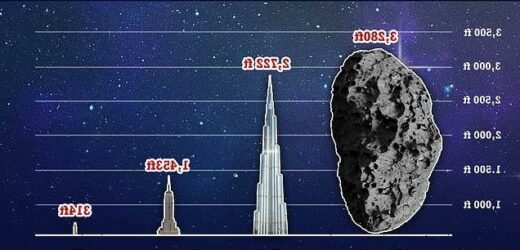Huge asteroid that is more than TWICE the size of the Empire State Building will race past Earth at 43,000 miles per hour next month
- Asteroid 7482 (1994 PC1) was first discovered by Australian astronomers in 1994
- It will be 1.2 million miles, or five times the distance to the Moon, from Earth
- This is the closest it has been since 1933 when it came 699,000 miles from Earth
- Its next close approach to the planet won’t be until 2105 according to NASA
A massive asteroid, more than twice the size of the Empire State Building in New York, will come within 1.2 million miles of the Earth next month, according to NASA.
The space rock, called 7482 (1994 PC1), poses no threat to the Earth as it will be five times further away from the planet than the Moon, as it shoots by at 43,000 mph.
According to NASA’s Center for Near Earth Object Studies (CNEOS) it is a ‘potentially hazardous object’ as it crosses Earth’s orbit as it travels around the Sun.
The rock is 3,280ft in diameter, and after its close approach on January 18, 2022, at 16:51 ET (21:51 GMT), it won’t be this close to the Earth again until 2105.
It will have a magnitude of 10 when it gets close, putting it out of reach for the naked eye and most binoculars, but should be visible using a back garden telescope.
A massive asteroid, more than twice the size of the Empire State Building in New York, will come within 1.2 million miles of the Earth next month, according to NASA
The space rock, called 7482 (1994 PC1), poses no threat to the Earth as it will be five times further away from the planet than the Moon, as it shoots by at 43,000 mph
ASTEROID 7482 (1994 PC1)
The space rock 7482 (1994 PC1) was first discovered in 1994.
It was spotted by RH McNaught using the Siding observatory in Australia.
It orbits the Sun every 572 days, although has an eccentric orbit taking it from 0.9 to 1.8 AU from the star.
One AU is the distance between the Earth and the Sun.
The last known approach this close was in 1933, when it was 699,000 miles from the Earth.
Asteroid 1994 PC1, which orbits the Sun every 1.5 years, was first discovered in 1994 by astronomer RH McNaught using the Siding observatory in Australia.
The last known approach this close was in 1933, when it was 699,000 miles from the Earth.
Its orbit is very well known, according to astronomers, and varies from 0.9 AU to 1.8 AU, where 1 AU is the distance between the Earth and the Sun.
It is a common stony S-type asteroid, and every close approach gives astronomers the chance to study the surface and learn more about these ancient space rocks.
NASA and other agencies regularly track more than 28,000 known asteroids as they orbit the Sun, and occasionally cross Earth’s orbit.
NASA says none of the known asteroids are expected to collide with the Earth at any point in the near future, but there are asteroids whose orbits aren’t known.
There are regular close approaches to the Earth, with the next, 2021 YK, coming 118,000 miles of the Earth on January 2, but it will be just 38ft across.
Asteroid 1994 PC1 won’t even be the only space rock to make a close approach on January 18 – it will be joined by the 70ft 2021 BA, that will come 2.3 million miles of the planet – or about twice as far away as 1994 PC1.
In an attempt to tackle the threat of asteroids that may one day get a little too close for comfort, NASA formed a planetary defence program, that includes the Double Asteroid Redirection Test (DART) mission, that launched last month.
DART was launched on a SpaceX Falcon 9 rocket and will see the probe crash head first into the surface of an asteroid.
It is heading for the small moonlet asteroid Dimorphos, which orbits a larger companion asteroid called Didymos.
The rock is 3,280ft in diameter, and after its close approach on January 18, 2022, at 16:51 ET (21:51 GMT), it won’t be this close to the Earth again until 2105
WHAT IS THE NASA DART MISSION?
DART will be the world’s first planetary defence test mission.
It is heading for the small moonlet asteroid Dimorphos, which orbits a larger companion asteroid called Didymos.
When it gets there it will be intentionally crashing into the asteroid to slightly change its orbit.
While neither asteroid poses a threat to Earth, DART’s kinetic impact will prove that a spacecraft can autonomously navigate to a target asteroid and kinetically impact it.
When it gets there it will be intentionally crashing into the asteroid to slightly change its orbit.
While neither asteroid poses a threat to Earth, DART’s kinetic impact will prove that a spacecraft can autonomously navigate to a target asteroid and kinetically impact it.
Then, using Earth-based telescopes to measure the effects of the impact on the asteroid system, the mission will enhance modelling and predictive capabilities to help us better prepare for an actual asteroid threat should one ever be discovered.
The DART technique could prove useful for altering the course of an asteroid years or decades before it bears down on Earth with the potential for catastrophe.
A small nudge ‘would add up to a big change in its future position, and then the asteroid and the Earth wouldn’t be on a collision course,’ NASA said.
Scientists constantly search for asteroids and plot their courses to determine whether they could hit the planet.
‘Although there isn’t a currently known asteroid that’s on an impact course with the Earth, we do know that there is a large population of near-Earth asteroids out there,’ said Lindley Johnson, NASA’s Planetary Defense Officer.
DEFLECTING AN ASTEROID WOULD REQUIRE ‘MULTIPLE BUMPS’, STUDY SAYS
Deflecting an asteroid such as Bennu, which has a small chance of hitting Earth in about a century and a half, could require multiple small impacts from some sort of massive human-made deflection device, according to experts.
Scientists in California have been firing projectiles at meteorites to simulate the best methods of altering the course of an asteroid so that it wouldn’t hit Earth.
According to the results so far, an asteroid like Bennu that is rich in carbon could need several small bumps to charge its course.
Bennu, which is about a third of a mile wide, has a slightly greater chance of hitting Earth than previously thought, NASA revealed earlier this month.
The space agency upgraded the risk of Bennu impacting Earth at some point over the next 300 years to one in 1,750.
Bennu also has a one-in-2,700 chance of hitting Earth on the afternoon of September 24, 2182, according to the NASA study.
Scientists have been seriously considering how to stop an asteroid from ever hitting Earth since the 1960s, but previous approaches have generally involved theories on how to blow the cosmic object into thousands of pieces.
The problem with this is these pieces could potentially zoom towards Earth and present almost as dangerous and humanity-threatening an issue as the original asteroid.
A more recent approach, called kinetic impact deflection (KID), involves firing something into space that more gently bumps the asteroid off course, away from Earth, while keeping it intact.
Recent KID efforts were outlined at the 84th annual meeting of the Meteoritical Society held in Chicago this month and led by Dr George Flynn, a physicist at State University of New York, Plattsburgh.
‘You might have to use multiple impacts,’ Dr Flynn said in conversation with The New York Times. ‘It [Bennu] may barely miss, but barely missing is enough.’
Researchers have been working at NASA’s Ames Vertical Gun Range, built in the 1960s during the Apollo era and based at Moffett Federal Airfield in California’s Silicon Valley, for the recent KID experiments.
They fired small, spherical aluminum projectiles at meteorites suspended by pieces of nylon string.
The team used 32 meteorites – which are fragments of asteroids that have fallen to Earth from space – that were mostly purchased from private dealers.
The tests have allowed them to work out at what point momentum from a human-made object fired towards an asteroid turns it into thousands of fragments, rather than knocking it off course as desired.
‘If you break it into pieces, some of those pieces may still be on a collision course with Earth,’ Dr Flynn said.
Carbonaceous chondrite (C-type) asteroids, such as Bennu, are the most common in the solar system.
They are darker than other asteroids due to the presence of carbon and are some of the most ancient objects in the solar system – dating back to its birth.
According to the findings from experiments at AVGR, the type of asteroid being targeted (and how much carbon it has in it) may dictate how much momentum would be directed at it from any human-made KID device.
From the experiments, the researchers found C-type meteorites could withstand only about one-sixth of the momentum that the other chondrites could withstand before shattering.
‘[C-type] asteroids are much more difficult to deflect without disruption than ordinary chondrite asteroids,’ the experts concluded.
‘These results indicate multiple successive impacts may be required to deflect rather than disrupt asteroids, particularly carbonaceous asteroids.’
Therefore, around 160 years in the future – when Bennu is most likely to collide with Earth, according to NASA – a KID device would have to give it a series of gentle nudges to prevent it from breaking up and sending dangerous splinter fragments flying towards Earth.
NASA’s recent study about Bennu, published in the journal Icarus, did point out there is more than a 99.9 per cent probability Bennu will not smash into Earth over the next three centuries.
‘Although the chances of it hitting Earth are very low, Bennu remains one of the two most hazardous known asteroids in our solar system, along with another asteroid called 1950 DA,’ NASA said in a statement.
Source: Read Full Article





